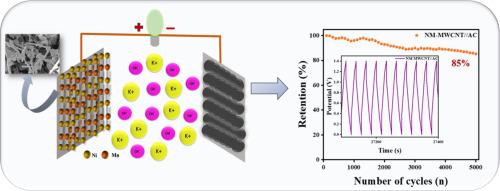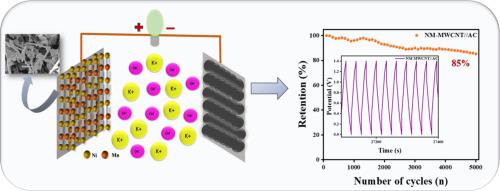Ni-Mn MOF复合材料的尺寸工程:揭示1D MWCNT和2D rGO对高性能超级电容器的电化学影响
IF 5.6
3区 材料科学
Q1 ELECTROCHEMISTRY
引用次数: 0
摘要
高性能、高能量密度的超级电容器对于推进电动汽车技术和支持清洁能源计划至关重要,因此需要具有优异电化学活性、稳定性和能量密度的电极材料。金属有机框架因其众多的氧化还原活性位点、可调节的孔隙率和巨大的表面积而成为未来超级电容器电极材料。为了提高储能性能,镍锰MOF复合材料中加入了还原氧化石墨烯和多壁碳纳米管(1D)。将Ni-Mn MOF与1D和2D碳质材料复合可诱导结构修饰,从而增强孔隙度、离子扩散和表面可及性,从而显著提高电化学性能。Ni-Mn MOF/MWCNT比Ni-Mn MOF/rGO复合材料的比电容(1153.9 F/g)比Ni-Mn MOF/rGO复合材料的比电容(826.8 F/g)提高,主要是由于MWCNT提供了导电途径,促进了更快的电子传递。离子动力学。Ni-Mn MOF/MWCNT //AC器件具有1.4 V的工作窗口,并在5000次循环中保持85%的优异保持率。该研究表明,一维MWCNT复合材料的电化学性能随着尺寸的变化而变化,因为它提供了离子迁移途径和对活性位点的优越利用,优于二维氧化石墨烯复合材料。本文章由计算机程序翻译,如有差异,请以英文原文为准。


Dimensional engineering of Ni-Mn MOF composites: Unveiling the electrochemical influence of 1D MWCNT and 2D rGO for high-performance supercapacitors
High-performance, energy-dense supercapacitors are crucial in advancing electric vehicle (EV) technology and supporting clean energy initiatives, necessitating electrode materials with superior electrochemical activity, stability, and energy density. Metal organic frameworks have garnered significant interest as possible futuristic supercapacitor electrode materials because of their numerous redox active sites, tunable porosity, and vast surface area. In order to boost the energy storage performance, nickel-manganese MOF composites were incorporated with reduced graphene oxide and multi-walled carbon nanotubes (1D). Compositing Ni-Mn MOF with 1D and 2D carbonaceous materials induced structural modification that enhanced porosity, ion diffusion, and surface accessibility, thereby significantly boosting electrochemical performance. The improved specific capacitance (1153.9 F/g) of Ni-Mn MOF/MWCNT than the Ni-Mn MOF/rGO composite (826.8 F/g) is mainly due to the conductive pathways provided by MWCNT, promoting faster electron transport. and ion kinetics. The Ni-Mn MOF/MWCNT //AC device exhibited a broadened operating window of 1.4 V and maintains an excellent retention rate 85 % for 5000 cycles. This study demonstrates that the electrochemical performance varied with the dimensional tailoring as the 1D MWCNT composite outperformed the 2D rGO counterpart by providing ion mobility pathways and superior utilization of active sites.
求助全文
通过发布文献求助,成功后即可免费获取论文全文。
去求助
来源期刊

Electrochimica Acta
工程技术-电化学
CiteScore
11.30
自引率
6.10%
发文量
1634
审稿时长
41 days
期刊介绍:
Electrochimica Acta is an international journal. It is intended for the publication of both original work and reviews in the field of electrochemistry. Electrochemistry should be interpreted to mean any of the research fields covered by the Divisions of the International Society of Electrochemistry listed below, as well as emerging scientific domains covered by ISE New Topics Committee.
 求助内容:
求助内容: 应助结果提醒方式:
应助结果提醒方式:


